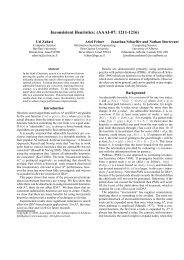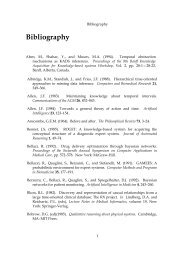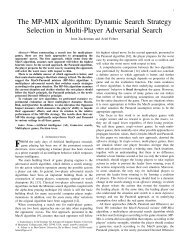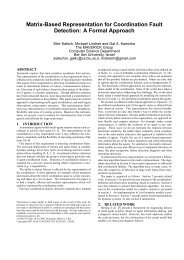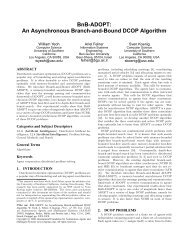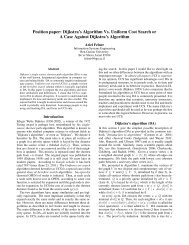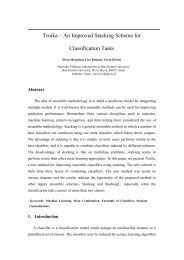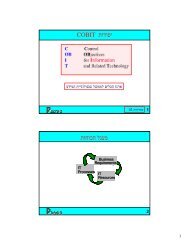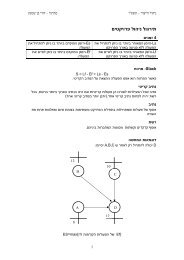Online Analytical Processing (OLAP) â Codd, 1993. OLAP ...
Online Analytical Processing (OLAP) â Codd, 1993. OLAP ...
Online Analytical Processing (OLAP) â Codd, 1993. OLAP ...
You also want an ePaper? Increase the reach of your titles
YUMPU automatically turns print PDFs into web optimized ePapers that Google loves.
<strong>Online</strong> <strong>Analytical</strong> <strong>Processing</strong><br />
(<strong>OLAP</strong>) – <strong>Codd</strong>, <strong>1993.</strong><br />
Definition (The <strong>OLAP</strong> Council):<br />
a category of software technology that enables<br />
analysts, managers, and executives to gain<br />
insight into data through fast, consistent,<br />
interactive access to a wide variety of possible<br />
views of information that has been transformed<br />
from raw data to reflect the real dimensionality<br />
of the enterprise as understood by the user<br />
<strong>OLAP</strong> Operations<br />
1<br />
2<br />
<strong>OLAP</strong><br />
• Support (almost) ad-hoc querying for business analyst<br />
• Think in terms of spreadsheets<br />
– View sales data by geography, time, or product<br />
• Extend spreadsheet analysis model to work with<br />
warehouse data<br />
– Large data sets<br />
– Combine interactive queries with reporting functions<br />
• Multidimensional view of data is the foundation of<br />
<strong>OLAP</strong><br />
– Data model, operations, etc.<br />
Data Warehousing and <strong>OLAP</strong><br />
• Although sometimes used interchangeably,<br />
the terms data warehousing and online<br />
analytical processing (<strong>OLAP</strong>) apply to<br />
different components of systems often<br />
referred to as decision support systems or<br />
business intelligence systems. Components<br />
of these types of systems include databases<br />
and applications that provide the tools<br />
analysts need to support organizational<br />
decision-making.<br />
3<br />
4<br />
1
Data Warehousing and <strong>OLAP</strong><br />
Data Warehousing and <strong>OLAP</strong><br />
• A data warehouse is a database containing data<br />
that usually represents the business history of an<br />
organization.<br />
• This historical data is used for analysis that<br />
supports business decisions at many levels, from<br />
strategic planning to performance evaluation of a<br />
discrete organizational unit.<br />
• Data in a data warehouse is organized to support<br />
analysis rather than to process real-time<br />
transactions as in online transaction processing<br />
systems (OLTP).<br />
Note for <strong>OLAP</strong> we need:<br />
Database (Data Warehouse Storage)<br />
<strong>OLAP</strong> Server<br />
<strong>OLAP</strong> Client (Like Data Analyzer or Excel)<br />
5<br />
6<br />
<strong>OLAP</strong> stages<br />
• picking the data from the data warehouse (DB)<br />
• building the “cube” (<strong>OLAP</strong> SERVER)<br />
– cube = pre-computation of “all” possible combinations<br />
The high performance comes from the fact that all the “queries”<br />
(combinations) have been anticipated.<br />
• playing with the “cube” (<strong>OLAP</strong> CLIENT)<br />
– slice-dice, roll-up/drill-down, etc.<br />
Three-Tier Decision Support Systems<br />
• Warehouse database server<br />
– Almost always a relational DBMS, rarely flat files<br />
• <strong>OLAP</strong> servers<br />
• Clients<br />
– Query and reporting tools<br />
– Analysis tools<br />
– Data mining tools<br />
7<br />
8<br />
2
The Complete Decision Support<br />
System<br />
<strong>OLAP</strong> Server: Query Engine<br />
Requirements<br />
Information Sources<br />
Semistructured<br />
Sources<br />
Data Warehouse<br />
Server<br />
(Tier 1)<br />
Data<br />
Warehouse<br />
<strong>OLAP</strong> Servers<br />
(Tier 2)<br />
e.g., M<strong>OLAP</strong><br />
serve<br />
Clients<br />
(Tier 3)<br />
Analysis<br />
• Aggregates (maintenance and querying)<br />
– Decide what to precompute and when<br />
• Query language to support<br />
multidimensional operations<br />
Operational<br />
DB’s<br />
extract<br />
transform<br />
load<br />
refresh<br />
etc.<br />
serve<br />
e.g., R<strong>OLAP</strong><br />
serve<br />
Query/Reporting<br />
Data Mining<br />
– Standard SQL falls short<br />
• Scalable query processing<br />
– Data intensive and data selective queries<br />
Data Marts<br />
9<br />
10<br />
<strong>OLAP</strong> Server Architectures<br />
R<strong>OLAP</strong><br />
• Relational <strong>OLAP</strong> (R<strong>OLAP</strong>)<br />
• Multidimensional <strong>OLAP</strong> (M<strong>OLAP</strong>)<br />
• Hybrid <strong>OLAP</strong> (H<strong>OLAP</strong>)<br />
• Desktop <strong>OLAP</strong> (D<strong>OLAP</strong>)<br />
• Relational <strong>OLAP</strong> (R<strong>OLAP</strong>)<br />
– Use relational or extended-relational DBMS to store<br />
and manage warehouse data and <strong>OLAP</strong> middle ware to<br />
support missing pieces<br />
– Include optimization of DBMS backend,<br />
implementation of aggregation navigation logic, and<br />
additional tools and services<br />
– greater scalability<br />
11<br />
12<br />
3
RDBMS<br />
Complicated SQL<br />
Results<br />
R<strong>OLAP</strong><br />
RDBMS As-Is not Appropriate For<br />
<strong>OLAP</strong><br />
• n-Dimensional Structure<br />
– Summarization may not be possible<br />
• End-User Confusion about SQL Query Tools<br />
• Poor Performance<br />
Relational DB Server<br />
R<strong>OLAP</strong> SERVER<br />
<strong>OLAP</strong> CLIENT<br />
13<br />
14<br />
Relational Table<br />
Product Region Sales<br />
Nuts East 50<br />
Nuts West 60<br />
Nuts Central 100<br />
Screws East 40<br />
Screws West 70<br />
Screws Central 80<br />
Bolts East 90<br />
Bolts West 120<br />
Bolts Central 140<br />
Washers East 20<br />
Washers West 10<br />
Washers Central 30<br />
2 Dimensional Matrix<br />
Sales Dimensioned By Products & Region<br />
East West Central<br />
Nuts 50 60 100<br />
Screws 40 70 80<br />
Bolts 90 120 140<br />
Washers 20 10 30<br />
No Standard SQL statement can return this structure of report<br />
15<br />
16<br />
4
SQL Extensions for <strong>OLAP</strong><br />
• Extended family of aggregate functions<br />
– rank( top 10), N_Tile (percentile, e.g., 30% for each product)<br />
• Reporting features<br />
– Matrix results<br />
• Results of multiple group by’s<br />
– Running totals, cumulative totals<br />
• Research on computing the cube efficiently<br />
– Share work among multiple group-by operations<br />
– Rollup requires single sort<br />
• Papers by J. Gray (cube & roll-up, supported in SQL<br />
Server 6.5) and Red Brick (RISQL)<br />
GROUPING SETS<br />
SELECT COURSE, YEAR, AVG(grade) as GRADES_AVG<br />
FROM GRADES<br />
GROUP BY GROUPING SETS ((COURSE,YEAR),(COURSE),())<br />
COURSE YEAR GRADES_AVG<br />
DB 1998 95.03<br />
DB 1999 93.00<br />
DB 94.01<br />
DW 1998 90.00<br />
DW 1999 95.00<br />
DW 92.50<br />
TOTAL 93.25<br />
17<br />
18<br />
MDX = “SQL” for Cubes instead for<br />
tables<br />
SELECT { Route.nonground.Members } ON COLUMNS,<br />
{Time.[1st half].Members } ON ROWS<br />
FROM TestCube<br />
WHERE ( [Measures].[Packages] )<br />
…<br />
M<strong>OLAP</strong><br />
• Multidimensional <strong>OLAP</strong> (M<strong>OLAP</strong>)<br />
– Array-based storage structures<br />
– Direct access to array data structures<br />
• The First Generation <strong>OLAP</strong>.<br />
• Good query performance<br />
• Not Flexible – Require Multi Dimensional Design<br />
• Require Expensive IT Resources.<br />
• very poor storage utilization when the data is<br />
sparse<br />
19<br />
20<br />
5
Pure M<strong>OLAP</strong><br />
Multi Dimensional DB<br />
H<strong>OLAP</strong><br />
M<strong>OLAP</strong> SERVER<br />
<strong>OLAP</strong> CLIENT<br />
Multi Dimensional DB<br />
M<strong>OLAP</strong> SERVER<br />
<strong>OLAP</strong> CLIENT<br />
R<strong>OLAP</strong> SERVER<br />
21<br />
22<br />
D<strong>OLAP</strong><br />
D<strong>OLAP</strong><br />
• Desktop <strong>OLAP</strong>.<br />
• For small databases.<br />
• Easy to integrate.<br />
Complicated SQL<br />
RDBMS<br />
Results<br />
Relational DB Server<br />
R<strong>OLAP</strong> Engine+<strong>OLAP</strong> Client<br />
23<br />
24<br />
6
<strong>Codd</strong>’s Criteria for <strong>OLAP</strong><br />
• Multi- Dimensional Conceptual View<br />
• Transparency<br />
• Accessibility – Different sources.<br />
• Consistent Reporting Performance<br />
• Dynamic Sparse Matrix Handling<br />
• Multi- User Support<br />
• Intuitive Data Manipulation<br />
• Unlimited Dimensions and Aggregation Levels<br />
<strong>Codd</strong>'s Paper<br />
25<br />
7



